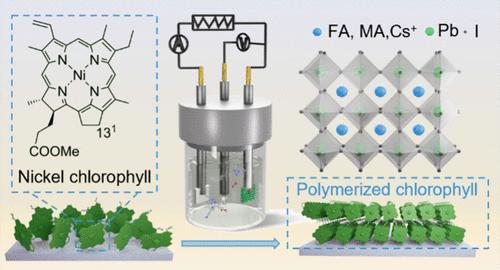镍叶绿素衍生空穴传输材料用于稳定高效的倒钙钛矿太阳能电池
IF 9.1
1区 材料科学
Q1 CHEMISTRY, MULTIDISCIPLINARY
引用次数: 0
摘要
空穴选择层(HSLs)是高效稳定的钙钛矿太阳能电池(PSCs)的关键材料。叶绿素(Chls)及其类似物具有独特的光电特性,使它们在光伏发电中具有吸引力。然而,无掺杂氯基材料仍未得到充分开发,据报道其功率转换效率(pce)低于19%。研究了三种氯代镍作为功能材料的单体。甲基邻苯二甲酸镍(NiChl-Oxo)由天然的Chl-a衍生而来,在c13 -酮羰基上进行化学修饰,得到NiChl-Deoxo和NiChl-CN。采用电化学聚合法制备相应的聚合镍氢化物薄膜。在没有掺杂剂的情况下,nichl - deoxbased PSCs的PCE达到了创纪录的21.8%,填充系数为83.8%,这是迄今为止报道的基于chl的PSCs的最高效率。此外,这些装置表现出优异的长期稳定性。该研究强调了战略性分子修饰在推进chl基材料方面的有效性,并为开发用于下一代psc的高性能、无掺杂hsl提供了一条有希望的途径。本文章由计算机程序翻译,如有差异,请以英文原文为准。

Nickel Chlorophyll-Derived Hole Transport Materials for Stable and Efficient Inverted Perovskite Solar Cells
Hole-selective layers (HSLs) are critical for efficient and stable perovskite solar cells (PSCs). Chlorophylls (Chls) and their analogs exhibit unique optoelectronic properties, making them attractive for photovoltaics. However, dopant-free Chl-based materials remain underexplored, with reported power conversion efficiencies (PCEs) below 19%. This study investigates three nickel chlorins (NiChls) as monomers for functional materials. Nickel methyl pyropheophorbide-a (NiChl-Oxo), derived from natural Chl-a, was chemically modified at the C13-keto-carbonyl group, yielding NiChl-Deoxo and NiChl-CN. Electrochemical polymerization was used to fabricate the corresponding polymerized NiChl films as HSLs. Without dopants, NiChl-Deoxo-based PSCs achieved a record PCE of 21.8%, with a fill factor of 83.8%, which is the highest reported efficiency for Chl-based PSCs to date. Additionally, these devices exhibited exceptional long-term stability. This study highlights the effectiveness of strategic molecular modifications in advancing Chl-based materials and presents a promising pathway for developing high-performance, dopant-free HSLs for next-generation PSCs.
求助全文
通过发布文献求助,成功后即可免费获取论文全文。
去求助
来源期刊

Nano Letters
工程技术-材料科学:综合
CiteScore
16.80
自引率
2.80%
发文量
1182
审稿时长
1.4 months
期刊介绍:
Nano Letters serves as a dynamic platform for promptly disseminating original results in fundamental, applied, and emerging research across all facets of nanoscience and nanotechnology. A pivotal criterion for inclusion within Nano Letters is the convergence of at least two different areas or disciplines, ensuring a rich interdisciplinary scope. The journal is dedicated to fostering exploration in diverse areas, including:
- Experimental and theoretical findings on physical, chemical, and biological phenomena at the nanoscale
- Synthesis, characterization, and processing of organic, inorganic, polymer, and hybrid nanomaterials through physical, chemical, and biological methodologies
- Modeling and simulation of synthetic, assembly, and interaction processes
- Realization of integrated nanostructures and nano-engineered devices exhibiting advanced performance
- Applications of nanoscale materials in living and environmental systems
Nano Letters is committed to advancing and showcasing groundbreaking research that intersects various domains, fostering innovation and collaboration in the ever-evolving field of nanoscience and nanotechnology.
 求助内容:
求助内容: 应助结果提醒方式:
应助结果提醒方式:


